Suppose I need to set an opacity mask on a WPF control that highlights a portion of it in precise position (suppose a 50x50 square at (50;50) position). To do that I create a DrawingGroup containing 2 GeometryDrawing objects: 1 semi-transparent rectangle for the whole actual size of the control and 1 opaque rectangle for highlighted area. Then I create a DrawingBrush from this DrawingGroup, set it's Stretch property to None and set this brush as OpacityMask of the control that needs to be masked.
All this works fine while nothing is "sticking" out of bounds of said control. But if control draws something outside of it's bounds the outer point becomes a starting point from where opacity mask is applied (if the brush is aligned to that side) and the whole mask shifts by that distance resulting in unexpected behavior.
I can't seem to find a way to force mask to be applied from control's bounds or at least get the actual bounds of the control (including sticking parts) so I can adjust my mask accordingly.
Any ideas highly appreciated!
Update: Here's a simple test-case XAML and screenshots demonstrating the issue:
We have 2 nested Borders and Canvas in the last one with the above mentioned square:
<Border Padding="20" Background="DarkGray" Width="240" Height="240">
<Border Background="LightBlue">
<Canvas>
<Rectangle Canvas.Left="50" Canvas.Top="50" Width="50" Height="50"
Stroke="Red" StrokeThickness="2"
Fill="White"
/>
</Canvas>
</Border>
</Border>
Here's how it looks:

(source: ailon.org)
Now we add an OpacityMask to the second border so that every part of it except our square is semi-transparent:
<Border.OpacityMask>
<DrawingBrush Stretch="None" AlignmentX="Left" AlignmentY="Top">
<DrawingBrush.Drawing>
<DrawingGroup>
<GeometryDrawing Brush="#30000000">
<GeometryDrawing.Geometry>
<RectangleGeometry Rect="0,0,200,200" />
</GeometryDrawing.Geometry>
</GeometryDrawing>
<GeometryDrawing Brush="Black">
<GeometryDrawing.Geometry>
<RectangleGeometry Rect="50,50,50,50" />
</GeometryDrawing.Geometry>
</GeometryDrawing>
</DrawingGroup>
</DrawingBrush.Drawing>
</DrawingBrush>
</Border.OpacityMask>
Everything looks as expected:

(source: ailon.org)
And now we add a line to the canvas that sticks 10 pixels out on the left of our border:
<Line X1="-10" Y1="150" X2="120" Y2="150"
Stroke="Red" StrokeThickness="2"
/>
And the mask shifts 10 pixels to the left:

(source: ailon.org)
Update2: As a workaround I add a ridiculously large transparent rectangle outside of bounds and adjust my mask accordingly but that is a really nasty workaround.
Update3: Note: The canvas with rectangle and line is there just as an example of some object that has something outside of it bounds. In context of this sample it should be treated as some sort of a black box. You can't change it's properties to solve the general issue. This would be the same as just moving the line so it doesn't stick out.